


xxxxxThe English writer R.D. Blackmore wrote fourteen novels, but he is remembered today for just one of them, the romantic story of Lorna Doone, published in 1870. An exciting tale, full of family feud, skulduggery and murder, and with a moving love story running throughout, it proved highly popular. And it was made the more compelling by the countryside in which it was set, the bleak heights and lush valleys of Exmoor in south-west England. Such was its impact that this area is known as “Lorna Doone Country” to this day. This one novel made Blackmore one of the outstanding literary figures of his day, and created a new romantic movement in English literature. He numbered among his friends and admirers the writers Thomas Hardy (who wrote somewhat similar novels based on Dorset), Robert Louis Stevenson, and James Barrie.
RICHARD DODDRIDGE BLACKMORE 1825 - 1900 (G4, W4, Va, Vb, Vc)
Acknowledgements
Blackmore: date and artist unknown. Country: contained in A Literary Tour of Devon, written by Paul Wreyford and illustrated by Mike Stonelake, published 1996. Malmsmead: contained in the eBook of Lorna Doone, A Romance of Exmoor, artist unknown – The Project Gutenberg. Ned Kelly: impression, artist unknown. Swinburne: by the English Pre-Raphaelite artist Dante Gabriel Rossetti (1828-1882), 1862 – Fitzwilliam Museum, University of Cambridge, England. Watts-Dunton: by the portrait painter Helen Bramwell Norris (1865-1927), 1902. Black Beauty: date and artist unknown.
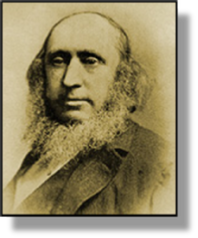 xxxxxThe English writer R.D Blackmore - as he was generally known - wrote a number of poems and fourteen novels. Today, however, he is known only for one but highly successful romance story - Lorna Doone, published in one volume in 1870. Set on Exmoor, an area of outstanding natural beauty in the south-west of England, it had all the makings of an exciting yarn and very soon became a classic, read the world over.
xxxxxThe English writer R.D Blackmore - as he was generally known - wrote a number of poems and fourteen novels. Today, however, he is known only for one but highly successful romance story - Lorna Doone, published in one volume in 1870. Set on Exmoor, an area of outstanding natural beauty in the south-west of England, it had all the makings of an exciting yarn and very soon became a classic, read the world over.
xxxxxBlackmore was born in Longworth, then in the county of Berkshire. He was educated at Blundells School, a public school in Tiverton, Devon, and won a scholarship to Exeter College, Oxford. He obtained a degree in classics in 1847 and decided to study law. He entered the Middle Temple in London two years later, and was called to the Bar in 1852, but then ill health - possibly the onset of epilepsy - prevented him from following his chosen career. As a result he became classic master at Wellesley Grammar School, Twickenham. He married in November 1853, and four years later, his life changed, much to his liking. He inherited quite a large sum of money from an uncle and he no longer had to work for a living. He bought a 16 acre plot in Teddington, Middlesex, built a large house on it, and settled down to grow fruit and try his hand at writing.
xxxxxHis market gardening project was never very successful and, for a time, neither was his work with the pen. He published several volumes of poetry, but these failed to impress and for that reason he turned to fiction. In this genre he fared better. His first two novels, Clara Vaughan in 1864 and Craddock Nowell two years later, were moderately successful, but it was his third novel that gave him a lasting name in English literature. Published as a three-volume work in 1869, it made no impact whatsoever, but the following year it was produced in one volume and within a short time Lorna Doone, a romance story set in the late 17th century, had won fame and fortune for its author.
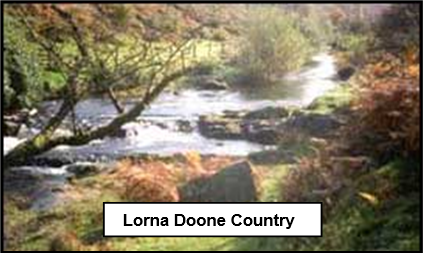 xxxxxThe extreme popularity of the novel took Blackmore - a quiet, unassuming man - by surprise. In fact, he considered his later novel, The Maid of Sker, published in 1872, more worthy of public acclaim. However, the imaginative Lorna Doone had all the ingredients of an exciting, romantic tale of high adventure: a bitter family feud, skulduggery and murder, plus a moving love story that is constantly in crisis and provides the final dramatic climax. And what made the story the more compelling was the wild countryside in which it was set: the remote magnificence of Exmoor
xxxxxThe extreme popularity of the novel took Blackmore - a quiet, unassuming man - by surprise. In fact, he considered his later novel, The Maid of Sker, published in 1872, more worthy of public acclaim. However, the imaginative Lorna Doone had all the ingredients of an exciting, romantic tale of high adventure: a bitter family feud, skulduggery and murder, plus a moving love story that is constantly in crisis and provides the final dramatic climax. And what made the story the more compelling was the wild countryside in which it was set: the remote magnificence of Exmoor 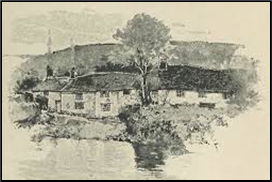 with its sweeping, sombre uplands - full of menace and foreboding - and the stunning beauty of Badgworthy Valley, home to Malmsmead, the farmstead of the Doones (illustrated). This area played such a prominent part in the novel as a whole, that it came to be known as “Lorna Doone Country”, and it still has that name today. As a boy Blackmore had spent much time on Exmoor, and his vivid descriptions of the countryside showed a deep love and understanding of nature and the rural way of life - including the regional dialects.
with its sweeping, sombre uplands - full of menace and foreboding - and the stunning beauty of Badgworthy Valley, home to Malmsmead, the farmstead of the Doones (illustrated). This area played such a prominent part in the novel as a whole, that it came to be known as “Lorna Doone Country”, and it still has that name today. As a boy Blackmore had spent much time on Exmoor, and his vivid descriptions of the countryside showed a deep love and understanding of nature and the rural way of life - including the regional dialects.
xxxxxLorna Doone established Blackmore as one of the foremost novelists of his time, and his novels helped to create a new romantic movement in English literature. Among his other works were Alice Lorraine (1875), Cripps the Carrier (1876), Christobell (1882), Springhaven (1887), Perlycross (1894), Tales from the Telling House (1896) and Dariel (1897).
xxxxxBlackmore’s wife Lucy died in January 1888, and he died twelve years later after a long and painful illness. In 1904 a committee which included his friends and admirers Thomas Hardy, Robert Louis Stevenson and James Barrie erected a memorial to him in Exeter Cathedral.
xxxxxIncidentally, the bleak area of Exmoor in Lorna Doone is very much like the part played by the fictitious Egdon Heath in Hardy’s novels, set in southern Dorset. And Hardy, who began writing in the early 1870s, also had a deep love of nature and a sound knowledge of rural life. ……
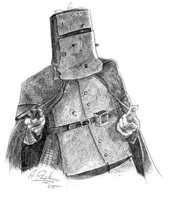
xxxxx…… The Blackmores had no children of their own, but they were very fond of Agnes’ four children (his wife’s sister). They helped with the cost of their education and virtually adopted one of them, a girl named Eva, when she was seven. ……
xxxxx…… It is said that Lorna Doone was a favourite with the Australian outlaw Ned Kelly, and that he might well have got the idea of wearing armour by reading about the Doones and their “iron plates on breast and head”.
Including:
Algernon Swinburne
and Anna Sewell

Vb-1862-1880-Vb-1862-1880-Vb-1862-1880-Vb-1862-1880-Vb-1862-1880-Vb-1862-1880-Vb
xxxxxThe English poet Algernon Charles Swinburne (1837-1909) came to prominence in 1865 with his Atalanta in Calydon, an ambitious Greek-style tragedy. The following year however, his Poems and Ballads, with its references to paganism and sexual perversion, attracted much criticism. This was followed in 1867 with Song of Italy and, four years later, Songs Before Sunset, a revolt against monarchy and the Roman Catholic Church. In the late 1870s his alcoholism and sexual depravity led to a physical and mental breakdown, but his friend Theodore Watts-Dunton took care of him, and his later poetic works and literary criticism marked him out as a man of letters. He wrote 14 volumes of poetry and 12 verse dramas, and his poetical works included Songs of Two Nations, the tragedies Bothwell and Erechtheus, Songs of Springtide and Tristram of Lyonesse. His poetry was florid in style, but the richness and intensity of its language, and the beauty and flow of its melody earned him a place in English literature. He numbered among his friends the Pre-Raphaelites Rossetti, Morris and Burne-Jones, and the writer George Meredith.
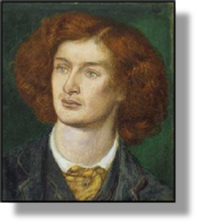 xxxxxIt was around this time, in 1866, that the English poet and critic Algernon Charles Swinburne (1837-1909) produced his first series of Poems and Ballads, a sensational work in the vogue of the French decadent poet Charles Baudelaire. Dealing in parts with paganism, the supernatural, and sexual perversion, it attracted a deal of violent criticism and was eventually withdrawn from publication. This, together with his debauched life style, earned him public disapproval, but in his later years, as a reformed character, he came to be regarded as a poet of distinction and a man of letters. The portrait is by his friend Dante Gabriel Rossetti.
xxxxxIt was around this time, in 1866, that the English poet and critic Algernon Charles Swinburne (1837-1909) produced his first series of Poems and Ballads, a sensational work in the vogue of the French decadent poet Charles Baudelaire. Dealing in parts with paganism, the supernatural, and sexual perversion, it attracted a deal of violent criticism and was eventually withdrawn from publication. This, together with his debauched life style, earned him public disapproval, but in his later years, as a reformed character, he came to be regarded as a poet of distinction and a man of letters. The portrait is by his friend Dante Gabriel Rossetti.
xxxxxSwinburne was born in London, but he spent his early years at his home at Bonchurch on the Isle of Wight and in Northumberland, where his grandfather lived. He was educated at Eton (1849-1853) and Balliol College Oxford (1856-1860), and it was there that he met and came to know three members of the Pre-Raphaelite Brotherhood, Dante Gabriel Rossetti, William Morris and Edward Burne-Jones, then occupied in painting their Arthurian murals on the walls of the Union. A confirmed atheist and republican, he left Oxford without completing his studies and settled in London to start a literary career. There he began a close association with the poet and painter Rossetti, and became friends with William Morris and the writer George Meredith. A highly strung and excitable person by nature, he was quickly drawn into the city’s low life, and soon became known for his excessive drinking and open debauchery, a reputation he appeared to enjoy. Some of his indulgences might well have been exaggerated - spread abroad simply as a means to shock - but the damage to his health was real and was to become life-threatening.
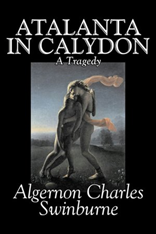 xxxxxIt was soon after arriving in London that he produced two verse dramas The Queen Mother and Rosamond, but it was not until 1865 that he came to prominence with his choral verse drama Atalanta in Calydon. This ambitious Greek-style tragedy was well received and demonstrated, even at this early stage, the richness and sustained melody of his lyric passages. The following year, however, came the publication of his Poems and Ballads, the contents of which shocked the general public - as he fully intended - and provoked a literary scandal. An article in the satirical magazine Punch referred to him as “Mr Swineborn”. Unperturbed, In 1867 he turned his attention to politics. In March of that year he met his idol the Italian patriot Giuseppe Mazzini, then in exile in England, and this meeting inspired his Song of Italy and, four years later, his Songs Before Sunset. In these poems his revolt against the restraints of moral convention was replaced by a revolt against the institution of monarchy and the Roman Catholic Church - then an obstacle to Italian unification. In these collections his highly ornate, melodic verse gave powerful expression to the revolutionary spirit and the lofty ideals of democracy.
xxxxxIt was soon after arriving in London that he produced two verse dramas The Queen Mother and Rosamond, but it was not until 1865 that he came to prominence with his choral verse drama Atalanta in Calydon. This ambitious Greek-style tragedy was well received and demonstrated, even at this early stage, the richness and sustained melody of his lyric passages. The following year, however, came the publication of his Poems and Ballads, the contents of which shocked the general public - as he fully intended - and provoked a literary scandal. An article in the satirical magazine Punch referred to him as “Mr Swineborn”. Unperturbed, In 1867 he turned his attention to politics. In March of that year he met his idol the Italian patriot Giuseppe Mazzini, then in exile in England, and this meeting inspired his Song of Italy and, four years later, his Songs Before Sunset. In these poems his revolt against the restraints of moral convention was replaced by a revolt against the institution of monarchy and the Roman Catholic Church - then an obstacle to Italian unification. In these collections his highly ornate, melodic verse gave powerful expression to the revolutionary spirit and the lofty ideals of democracy.
x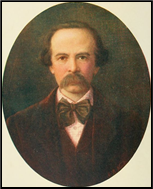 xxxxByxthe end of the 1870s his alcoholism and his sexual depravity had brought him to a physical and mental breakdown. It was at this stage - fortunately for him - that he was rescued by a friend, the solicitor and part-time poet and critic Theodore Watts-Dunton (1832-1914) (illustrated). He took him into his home in Putney and cared for him until his death in 1909. Given this new lease of life and the healthy environment it provided, Swinburne became a reformed individual. In the latter part of his career he turned his attention to landscape verse and literary criticism, and became a respected man of letters. He died in London at the age of 72, and was buried at Bonchurch, Ventnor, his family home on the isle of Wight.
xxxxByxthe end of the 1870s his alcoholism and his sexual depravity had brought him to a physical and mental breakdown. It was at this stage - fortunately for him - that he was rescued by a friend, the solicitor and part-time poet and critic Theodore Watts-Dunton (1832-1914) (illustrated). He took him into his home in Putney and cared for him until his death in 1909. Given this new lease of life and the healthy environment it provided, Swinburne became a reformed individual. In the latter part of his career he turned his attention to landscape verse and literary criticism, and became a respected man of letters. He died in London at the age of 72, and was buried at Bonchurch, Ventnor, his family home on the isle of Wight.
xxxxxSwinburne wrote more than 35 books, including 12 verse dramas and 14 volumes of poetry, but, in the main, his reputation as a great poet rests upon a small number of poems, and these include, as 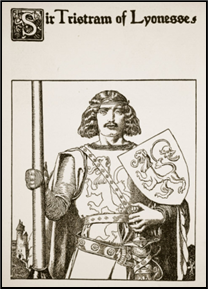 mentioned earlier, Atalanta in Calydon (1865), Poems and Ballades (1866), and Songs Before Sunrise (1871). To these must be added Songs of Two Nations, and the tragedies Bothwell and Erechtheus in the 1870s, and, in the 1880s, Songs of Springtide, A Century of Roundels, and Tristram of Lyonesse, a modern love story in the Arthurian tradition. In general his later poems were subdued and less vigorous than his earlier works, but in his nature studies his style remained rich and powerful. Some of the poems in his collection A Channel Passage, published in 1904 - such as The Lake of Gaube - are particularly beautiful. His literary criticism, notably his appraisals of Shakespeare, Ben Jonson, William Blake and Charlotte Bronte have some merit, but he did not really possess the temperament for reasoned, considered judgment.
mentioned earlier, Atalanta in Calydon (1865), Poems and Ballades (1866), and Songs Before Sunrise (1871). To these must be added Songs of Two Nations, and the tragedies Bothwell and Erechtheus in the 1870s, and, in the 1880s, Songs of Springtide, A Century of Roundels, and Tristram of Lyonesse, a modern love story in the Arthurian tradition. In general his later poems were subdued and less vigorous than his earlier works, but in his nature studies his style remained rich and powerful. Some of the poems in his collection A Channel Passage, published in 1904 - such as The Lake of Gaube - are particularly beautiful. His literary criticism, notably his appraisals of Shakespeare, Ben Jonson, William Blake and Charlotte Bronte have some merit, but he did not really possess the temperament for reasoned, considered judgment.
xxxxxIn general, Swinburne’s poetry is elaborately ornate and sometimes quite obscure - with rhyme often taking precedence over meaning - but the richness and intensity of its language, its genuine emotion, and the intrinsic beauty and flow of its melody puts him among the greatest of English poets. Rossetti wrote: “His golden words, like the beams of morning and the evening sun, flush into splendour whatever they fall upon”. And whilst much of his work is strange and wild in its music (described by John Ruskin as “a frenzied rush of rhythm”), it also possesses a softer, mellow tone, seen at its best in poems like The Forsaken Garden and Ballad of Dreamland. Technically, his experiments in rhyme and metre - during which he devised the roundel - played a part in freeing English poetry from the restrictions of formalism, with its set means of creating poetic effect.
xxxxxIncidentally, Rossetti used to call him “my little Northumberland friend” (Swinburne was only 5ft 4ins tall). They lived together in a house in Chelsea, London, for some years, and it was during that time that Swinburne took to heavy drinking and began frequenting the flesh pots of the city. ……
xxxxx…… One of his roundels, A Baby’s Death, was put to music by the English composer Sir Edward Elgar. His Poems and Ballads of 1878 contains the moving elegy “Ave Atque Vale”, (Hail and Farewell), written in praise of the French poet Charles Baudelaire.
xxxxxThe classic novel Black Beauty was published in 1877, the work of the English author Anna Sewell (1820-1878). She became disabled at the age of 12, following a fall, but she acquired a love of horses by riding a pony and chaise, and in the last years of her life wrote the story of a horse, told by the horse itself. Produced with the aim of encouraging kinder treatment towards horses, it became one of the best selling books of all time, published worldwide.
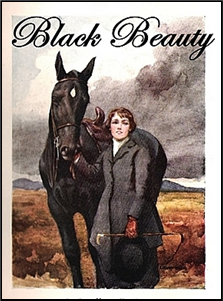 xxxxxIt was in 1877, the year Algernon Swinburne produced his Note on Charlotte Bronte, that the classic novel Black Beauty was published. It was an instant success, and became one of the best selling books of all time, with 50 million copies sold worldwide. Its author, Anna Sewell (1820-1878), disabled from childhood, wrote her one and only novel in the last years of her life, and just lived long enough to see it published. Narrated in the first person, the story is told through the eyes of a horse, and this novel approach proved extremely effective.
xxxxxIt was in 1877, the year Algernon Swinburne produced his Note on Charlotte Bronte, that the classic novel Black Beauty was published. It was an instant success, and became one of the best selling books of all time, with 50 million copies sold worldwide. Its author, Anna Sewell (1820-1878), disabled from childhood, wrote her one and only novel in the last years of her life, and just lived long enough to see it published. Narrated in the first person, the story is told through the eyes of a horse, and this novel approach proved extremely effective.
xxxxxSewell was born into a Quaker family at Great Yarmouth, Norfolk, England, and as a young child was educated at home. The family moved to Stoke Newington, just north of London, in 1832, and it was there at the age of 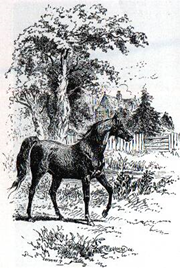 12 that she fell heavily while walking home from school and injured both ankles. The injury made here lame for the rest of her life, but she was able to drive a pony and chaise, and it was from this activity that she acquired a deep love of horses. It was not until the early 1870s, however, when she was living in Old Catton, a village near Norwich, Norfolk, that she began to compile the story of Black Beauty. Bedridden by this time, she wrote the story down on slips of paper or dictated it to her mother. Subtitled The Autobiography of a Horse, it told in simple but endearing fashion the hardships he suffered and the happiness he enjoyed at the hands of his different owners. The aim of the story, as she put it, was to “induce kindness, sympathy and an understanding treatment of horses”.
12 that she fell heavily while walking home from school and injured both ankles. The injury made here lame for the rest of her life, but she was able to drive a pony and chaise, and it was from this activity that she acquired a deep love of horses. It was not until the early 1870s, however, when she was living in Old Catton, a village near Norwich, Norfolk, that she began to compile the story of Black Beauty. Bedridden by this time, she wrote the story down on slips of paper or dictated it to her mother. Subtitled The Autobiography of a Horse, it told in simple but endearing fashion the hardships he suffered and the happiness he enjoyed at the hands of his different owners. The aim of the story, as she put it, was to “induce kindness, sympathy and an understanding treatment of horses”.
xxxxxHer mother, Mary Wright Sewell, was herself a popular writer of children’s stories, and Sewell spent long hours editing her mother’s works. This task doubtless helped her when she came to write her own novel.
xxxxxIncidentally, her birthplace in Church Plain, Great Yarmouth, is now a museum, and in Norwich there is a memorial fountain to her at the entrance to Sewell Park.






 xxxxxThe English writer R.D Blackmore -
xxxxxThe English writer R.D Blackmore - xxxxxThe extreme popularity of the novel took Blackmore -
xxxxxThe extreme popularity of the novel took Blackmore - with its sweeping, sombre uplands -
with its sweeping, sombre uplands -

 xxxxxIt was around this time, in 1866, that the English poet and critic Algernon Charles Swinburne (1837-
xxxxxIt was around this time, in 1866, that the English poet and critic Algernon Charles Swinburne (1837- xxxxxIt was soon after arriving in London that he produced two verse dramas The Queen Mother and Rosamond, but it was not until 1865 that he came to prominence with his choral verse drama Atalanta in Calydon. This ambitious Greek-
xxxxxIt was soon after arriving in London that he produced two verse dramas The Queen Mother and Rosamond, but it was not until 1865 that he came to prominence with his choral verse drama Atalanta in Calydon. This ambitious Greek- xxxxByxthe end of the 1870s his alcoholism and his sexual depravity had brought him to a physical and mental breakdown. It was at this stage -
xxxxByxthe end of the 1870s his alcoholism and his sexual depravity had brought him to a physical and mental breakdown. It was at this stage - mentioned earlier, Atalanta in Calydon (1865), Poems and Ballades (1866), and Songs Before Sunrise (1871). To these must be added Songs of Two Nations, and the tragedies Bothwell and Erechtheus in the 1870s, and, in the 1880s, Songs of Springtide, A Century of Roundels, and Tristram of Lyonesse, a modern love story in the Arthurian tradition. In general his later poems were subdued and less vigorous than his earlier works, but in his nature studies his style remained rich and powerful. Some of the poems in his collection A Channel Passage, published in 1904 -
mentioned earlier, Atalanta in Calydon (1865), Poems and Ballades (1866), and Songs Before Sunrise (1871). To these must be added Songs of Two Nations, and the tragedies Bothwell and Erechtheus in the 1870s, and, in the 1880s, Songs of Springtide, A Century of Roundels, and Tristram of Lyonesse, a modern love story in the Arthurian tradition. In general his later poems were subdued and less vigorous than his earlier works, but in his nature studies his style remained rich and powerful. Some of the poems in his collection A Channel Passage, published in 1904 - xxxxxIt was in 1877, the year Algernon Swinburne produced his Note on Charlotte Bronte, that the classic novel Black Beauty was published. It was an instant success, and became one of the best selling books of all time, with 50 million copies sold worldwide. Its author, Anna Sewell (1820-
xxxxxIt was in 1877, the year Algernon Swinburne produced his Note on Charlotte Bronte, that the classic novel Black Beauty was published. It was an instant success, and became one of the best selling books of all time, with 50 million copies sold worldwide. Its author, Anna Sewell (1820- 12 that she fell heavily while walking home from school and injured both ankles. The injury made here lame for the rest of her life, but she was able to drive a pony and chaise, and it was from this activity that she acquired a deep love of horses. It was not until the early 1870s, however, when she was living in Old Catton, a village near Norwich, Norfolk, that she began to compile the story of Black Beauty. Bedridden by this time, she wrote the story down on slips of paper or dictated it to her mother. Subtitled The Autobiography of a Horse, it told in simple but endearing fashion the hardships he suffered and the happiness he enjoyed at the hands of his different owners. The aim of the story, as she put it, was to “induce kindness, sympathy and an understanding treatment of horses”.
12 that she fell heavily while walking home from school and injured both ankles. The injury made here lame for the rest of her life, but she was able to drive a pony and chaise, and it was from this activity that she acquired a deep love of horses. It was not until the early 1870s, however, when she was living in Old Catton, a village near Norwich, Norfolk, that she began to compile the story of Black Beauty. Bedridden by this time, she wrote the story down on slips of paper or dictated it to her mother. Subtitled The Autobiography of a Horse, it told in simple but endearing fashion the hardships he suffered and the happiness he enjoyed at the hands of his different owners. The aim of the story, as she put it, was to “induce kindness, sympathy and an understanding treatment of horses”. 

